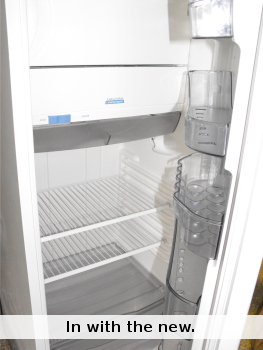
Out with the mold
 To energy star or not to energy star?
That was the question when our fridge started to die over a month
ago. Refrigerators are the single largest drain of electricity in
most households, sucking up about 14% of your energy usage.
That's money going down the drain and pollutants going into the
air. But could we afford to go green?
To energy star or not to energy star?
That was the question when our fridge started to die over a month
ago. Refrigerators are the single largest drain of electricity in
most households, sucking up about 14% of your energy usage.
That's money going down the drain and pollutants going into the
air. But could we afford to go green?
You can download
a very useful spreadsheet of energy star appliances' features and
energy ratings here.
I was curious about whether the label was a marketing gimmick, but
perusal of the spreadsheet made it clear that energy star fridges do
save electricity, often 100 KWH per year or more. The problem with energy star
is that new models are out of our price range, with
the cheapest ones going for over $500. No one seems to be willing
to sell used ones at all.
 Instead, we decided to buy a
small (9.7 cubic foot), non-energy star refrigerator. Small is a
plus for us since I'm a maniac about eating up leftovers promptly,
resulting in a fridge which is usually half empty. The new fridge
would cost about $350 plus tax and uses a similar amount of electricity
as the larger, energy star models. (There are small, energy star
models, but no one seems to carry them.)
Instead, we decided to buy a
small (9.7 cubic foot), non-energy star refrigerator. Small is a
plus for us since I'm a maniac about eating up leftovers promptly,
resulting in a fridge which is usually half empty. The new fridge
would cost about $350 plus tax and uses a similar amount of electricity
as the larger, energy star models. (There are small, energy star
models, but no one seems to carry them.)
But on our way to Lowes, we stumbled across a used appliance store
which just happened to have a small used fridge. We pulled it
away from the wall and wrote down its model number, then hurried north
to a library fifteen minutes away to look up its ratings. The
used Whirlpool fridge is rated at 310 KWH per year (significantly less than both the locally
available energy stars and the small non-energy star we had our eye
on), has a slightly large capacity than the small new one, and was selling for $150. I
thought my day couldn't get any better...then Mark bargained them down
to $125. And now I'm dreaming of non-powdered milk, butter that
doesn't melt in the door of the fridge, and unmoldy hotdogs....
Want more in-depth information? Browse through our books.
Or explore more posts by date or by subject.
About us: Anna Hess and Mark Hamilton spent over a decade living self-sufficiently in the mountains of Virginia before moving north to start over from scratch in the foothills of Ohio. They've experimented with permaculture, no-till gardening, trailersteading, home-based microbusinesses and much more, writing about their adventures in both blogs and books.
Want to be notified when new comments are posted on this page? Click on the RSS button after you add a comment to subscribe to the comment feed, or simply check the box beside "email replies to me" while writing your comment.

- Remove comment

- Remove comment
